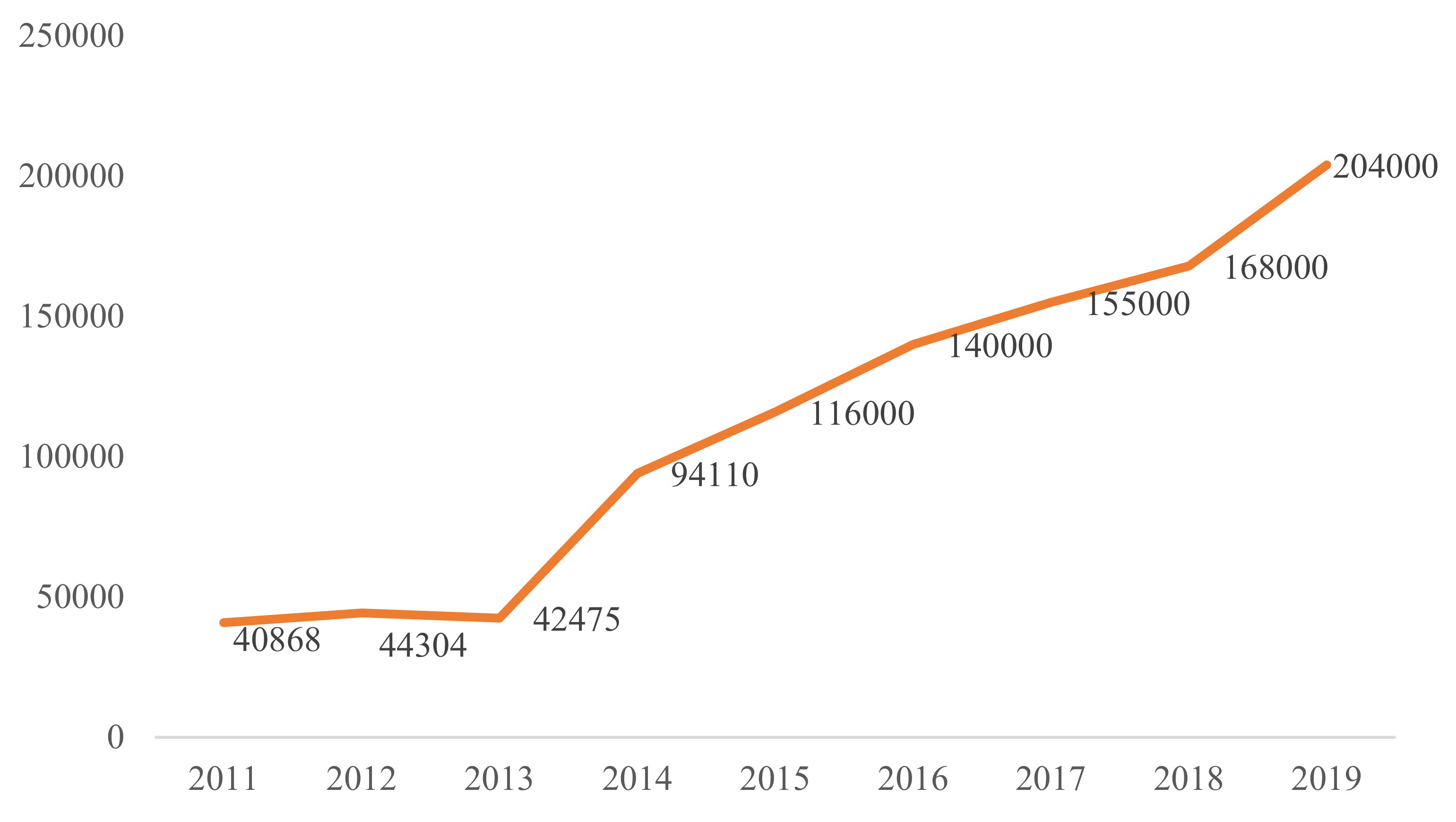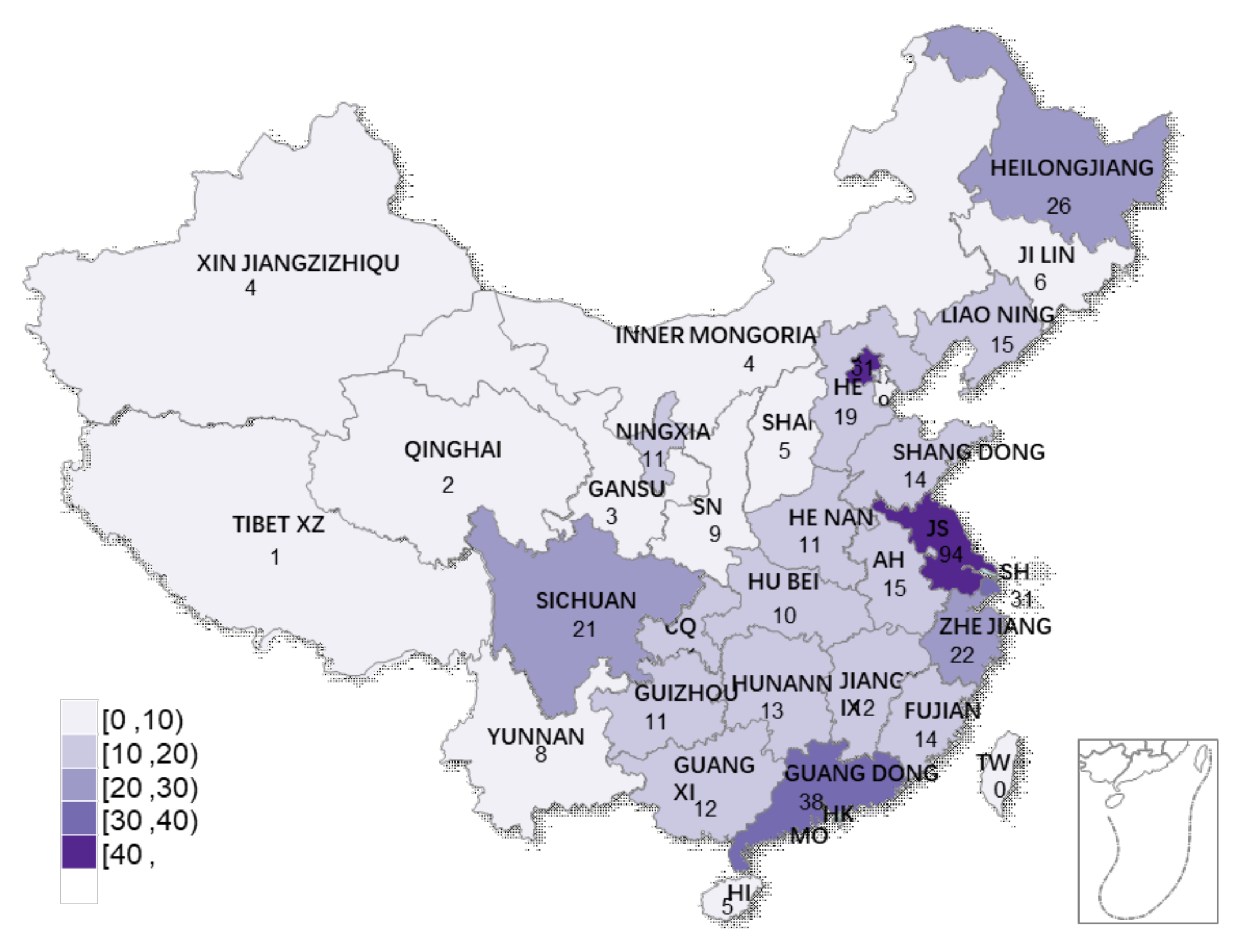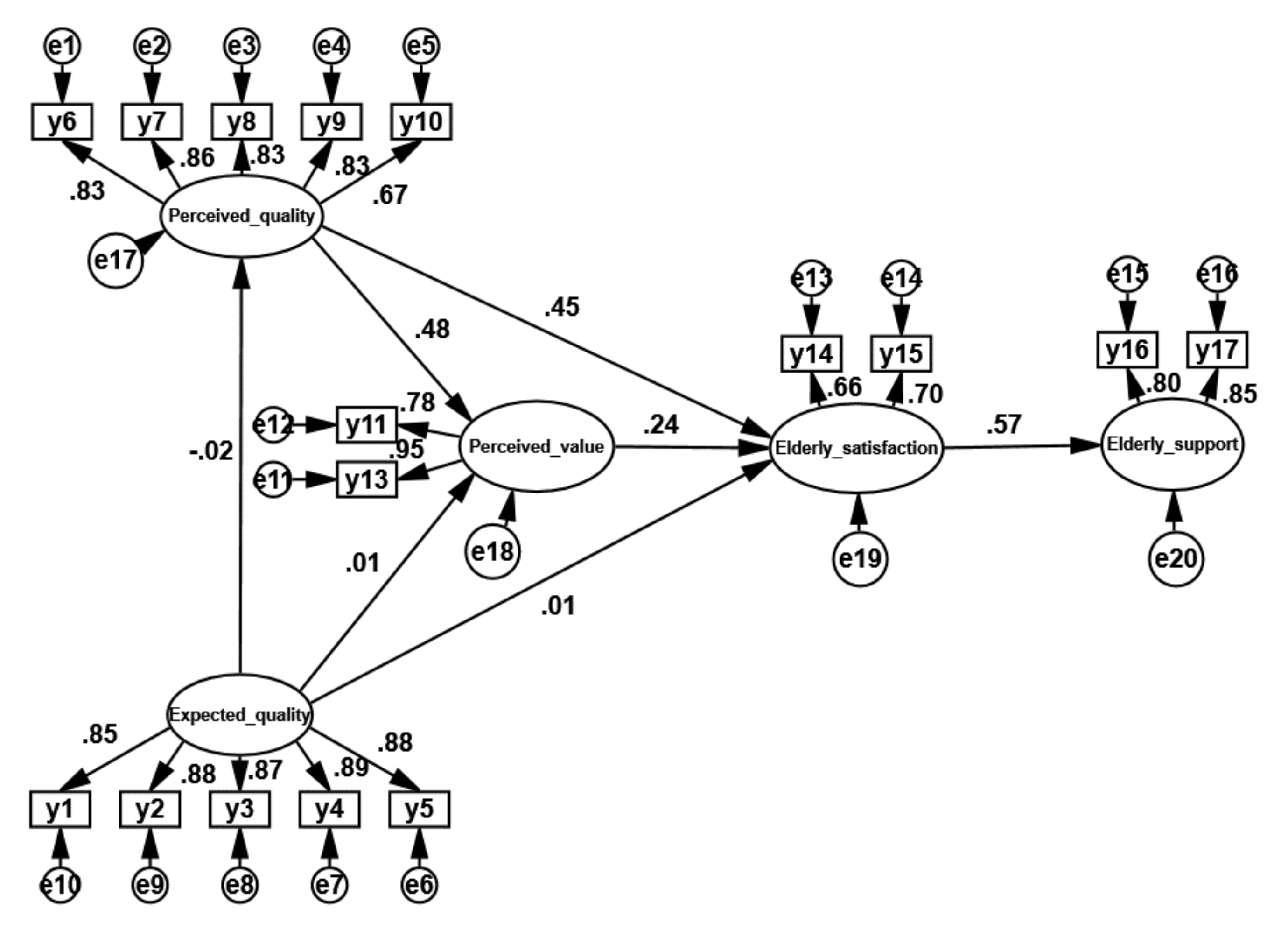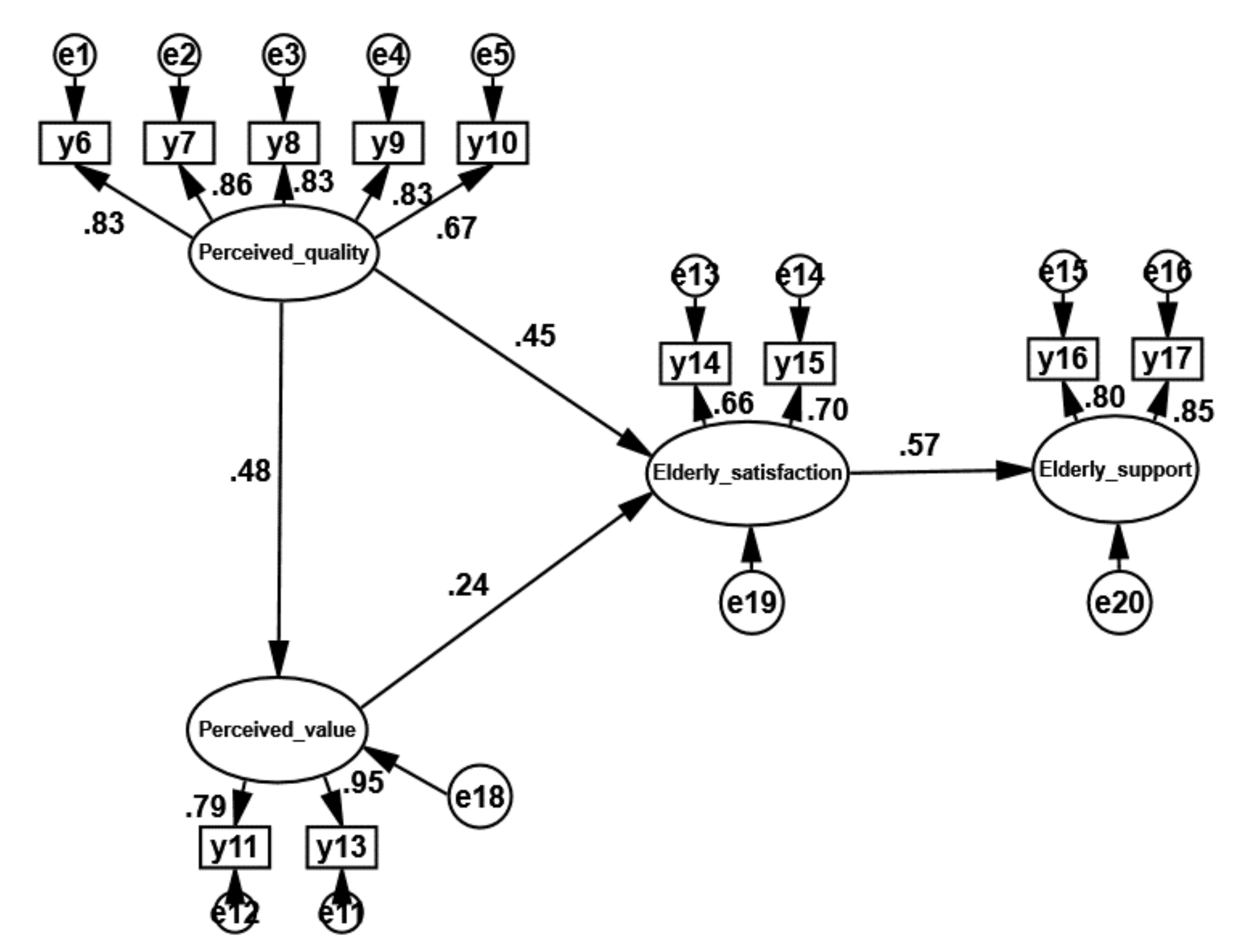1.1. Background
Since the second half of the 20th century, the decline in fertility levels and the increase in life expectancy have become the main themes of world population development. The global population over the age of 60 is increasing at a rate of approximately 3% per year [
1]. It is estimated that by 2050, the proportion of elderly individuals in all regions except Africa will be close to or greater than 25%, and the global ageing trend will be difficult to reverse [
2]. The ageing of the population continues to deepen, with elderly individuals placing a huge burden on families and society. Driven by ageing, as well as the development of industrialization and urbanization, many urban elderly individuals in China are quicker than rural elderly individuals to change their concept of old-age care and enter nursing homes for care in their old age [
3].
Since 2011, professional elderly nursing homes have played an increasingly important role in the development of the elderly care service industry [
4]. Various types of elderly nursing homes in China have increased from 40,900 in 2011 to 204,000 in 2019 [
5], and the elderly care service industry has rapidly developed (see
Figure 1). However, the development of the nursing care service industry in China, like other developing countries, is relatively late, and the quality of service is uneven [
6]. At present, nursing homes in China are in short supply. The elderly in China needs 8 million beds, but currently there are only 2.662 million [
7], which implicates that there is a large gap between supply and demand. The supply of old-age service facilities is mainly in the form of private operation. There are various old-age services on the market, and the elderly can choose freely according to their personal needs and preferences. The prices of each nursing home are inconsistent, and there are also gaps in the quality of services corresponding to different prices. Take a nursing home in Jiangsu as an example. Its charging items include bed fees, service fees, meal fees, special service fees, and medical rehabilitation fees. The types of rooms provided range from double, quadruple, and quintuple rooms, and a monthly fee ranging from CNY 6800 to CNY 25000 [
8] is established based on the ability of the elderly or children to pay. The high-quality development of nursing homes for elderly individuals is not only conducive to taking care of elderly individuals in their old age but also conducive to the stable development of an ageing society [
9]. Therefore, at present, what is the quality of elderly care services in China, and what is the level of satisfaction of elderly individuals in nursing homes with the services of the nursing homes? In addition, starting on January 19, 2020, COVID-19 broke out in Wuhan and quickly spread to 34 provinces in China. Studies have found that elderly people with chronic diseases or compromised immune systems are at greater risk of infection [
10]. After the outbreak, many nursing homes had cases of community infection, and they became high-risk places for virus infection. To reduce the risk of COVID-19 infection, many nursing homes have adopted closed management measures, such as declining visits by family members of the elderly [
11]. During the outbreak, what has been the level of satisfaction of Chinese elderly individuals in nursing homes?
Regarding the satisfaction of urban elderly people with nursing services, some scholars have investigated elderly individuals in nursing homes in Kunming City [
12] and Datong City [
13]. The results show that elderly individuals are more satisfied in nursing services. The overall level of satisfaction is relatively high; however, some scholars [
14] surveyed elderly individuals in 13 cities in Jiangsu Province and found that elderly residents are less satisfied with nursing services. In terms of the theoretical basis and methods of satisfaction evaluation, some academic circles take expectancy theory as the basis and analyze the gap between the service quality expected by elderly individuals and perceived service quality through confirmatory factor analysis and exploratory factor analysis to evaluate nursing service satisfaction evaluation. Some scholars have also used SERVQUAL [
15] and the analytic hierarchy process (AHP) [
16] models to set up more detailed service evaluation indicators to evaluate nursing service satisfaction. In recent years, some scholars have explored the use of the customer satisfaction model (American Customer Satisfaction Index (ACSI)) to evaluate satisfaction with elderly care services [
17]. Zheng Shengqin [
18] and others proposed that they can try to use the customer satisfaction model to study the nursing service satisfaction of urban elderly people. At the same time, when using the customer satisfaction model for evaluation, studies have found that the expectations, perceived quality, and perceived value of elderly individuals have a significant positive impact on their satisfaction and indirectly affect their loyalty through satisfaction. However, scholars such as Liu Wei [
19] conducted a satisfaction evaluation of 16 elderly care institutions in Harbin City, finding that there is no direct relationship between expected quality and nursing service satisfaction.
Among the existing research conclusions, those on the degree of satisfaction of Chinese elderly people with nursing services are not consistent. Some scholars believe that elderly people are more satisfied with nursing services, while others believe that most elderly people are not satisfied with nursing services. At the same time, the academic community has just begun to try to use the customer satisfaction model to study satisfaction with elderly care services. Among the existing research conclusions, some scholars believe that expected quality can significantly affect the satisfaction of elderly people with nursing services. However, other scholars have found that there is no correlation between the quality expected by and the satisfaction of elderly people with nursing services, and the research conclusions are contradictory. Taking China as an example, this study tries to use the ACSI model to evaluate the satisfaction of urban elderly people with nursing services, finding deficiencies in elderly care services. This study provides a basis for decision-making for the development of the elderly care industry in China. At the same time, by studying the effects of factors such as perceived quality and perceived value, it provides support for improving customer satisfaction models. Based on the inconsistency between customer satisfaction theory and expectation inconsistency theory, this paper proposes hypotheses and constructs theoretical models, conducts online questionnaire surveys of elderly individuals in China, and uses structural equation modeling (SEM) to verify the research hypotheses and validate theoretical models.
1.2. Hypothesis Development
We established the theoretical basis of the article based on customer satisfaction theory and expectation inconsistency theory.
In 1960, Cardozo [
20] conducted the first experimental study on customer satisfaction in the field of marketing and proposed that customer satisfaction would drive repurchase behavior. In 1989, scholars such as Sweden [
21] proposed Swedish customer satisfaction theory on this basis. Fornell [
22] and others believe that analyses of customer satisfaction also need to consider perceived quality and, on this basis, propose the ACSI model.
Expectation inconsistency theory holds that customers have an expectation of a product’s utility before purchasing the product and then compare their actual utility perception with their expectation after using the product. When the utility perception just reaches the expected level, it will produce a “completely consistent” mental state; exceeding the expected level will produce a “positive inconsistency” mental state; when it is below the expected level, a “negative inconsistent” mental state will occur. This consistent or inconsistent psychological state produced by the interaction between the expected level and the actual perception will directly affect the customer’s satisfaction with the product or service. Negative inconsistency will lead to customer dissatisfaction, positive inconsistency will lead to customer surprises beyond satisfaction, and complete agreement will result in customer satisfaction [
23]. This theory believes that customer satisfaction is the result of customers comparing their expectations of a product before purchase with the actual experience after purchase. There is a non-linear relationship between different levels of customer satisfaction and customer loyalty, and the perceived value and expectations of products/services will affect customer satisfaction.
1.2.1. Expected Quality
Expected quality means that customers will have expectations of quality based on past experience or external information before using products or services [
24]. Expectation inconsistency theory holds that the expectations formed by customers before consumption are compared with their actual feelings of consumption and that the size and direction of the gaps produced determine whether customers are satisfied and the degree of satisfaction [
25]. The expectation inconsistency model points out that the gap between the actual performance level of consumer products and the expectations before purchase will make customers have different “satisfying” responses. At the same time, Gronroos [
26] believes that service quality refers to the difference between service expectations and perceived service performance. When the service expectation is higher than the perceived service performance, the service quality is poor; conversely, when the perceived service performance is higher than the service expectation, the service quality is better. Based on the above analyses, the following hypotheses (H1-H3) are proposed:
Hypotheses 1 (H1). Expected quality is positively correlated with elderly satisfaction.
Hypotheses 2 (H2). Expected quality is positively correlated with perceived value.
Hypotheses 3 (H3). Expected quality is positively correlated with perceived quality.
1.2.2. Perceived Quality
Perceived quality is the subjective feelings of customers about the quality of the products or services they consume [
27]. These feelings of experience will be one of the key research contents of the entire evaluation model. Wang Feiyan and Li Zuwu [
28] believe that service is unique. Customer satisfaction with service-oriented enterprises is considered based on the entire service consumption process. Service (perceived) quality is the core factor that affects customer satisfaction and is the premise of customer satisfaction. Conducting empirical research, Zeithaml [
29] concluded that service quality has a significant positive impact on cognitive value. When elderly people choose nursing homes, they have psychological expectations based on the information they have obtained. After living in nursing homes and actually experiencing the quality of their services, they will have a satisfaction evaluation of the services of the nursing homes. The higher the satisfaction level is, the easier it will be to re-use such services. Based on the above analyses, the following hypotheses (H4-H5) are proposed:
Hypotheses 4 (H4). Perceived quality is positively correlated with elderly satisfaction.
Hypotheses 5 (H5). Perceived quality is positively correlated with perceived value.
1.2.3. Perceived Value
Perceived value is defined as the overall evaluation of product effectiveness based on customers’ total perceived costs and gains. In sociology, psychology, and organizational behavior, fairness is a concept that has received considerable attention; Oliver [
30] and others have performed a series of studies. The results show that whether customers are satisfied with a product depends not only on their comparison between expectations and performance but also on whether customers believe that the transaction is fair and reasonable. When customers feels that the ratio of utility to investment is the same as that of the product provider, they will feel that the transaction was fair and will be satisfied. The higher the degree of fairness is, the more satisfied the customers are. Conversely, the lower the degree of fairness is, the more dissatisfied the customers are. After elderly individuals actually perceive nursing services, whether the perceived quality is worth the cost will produce satisfaction. Based on the above analysis, the following hypothesis is proposed:
Hypotheses 6 (H6). Perceived value is positively correlated with elderly satisfaction.
1.2.4. Elderly Support
Customer loyalty (elderly support) refers to the possibility of customers repeating purchases and reserved prices [
31]. Customer satisfaction (elderly satisfaction) is the level of a person’s psychological state, reflecting the basic attitude of a customer towards products or services, and it is the key to whether consumption can be repeated. In a study of the factors affecting nursing service satisfaction, Hua Zhaohong [
32] found that elderly people’s satisfaction with nursing services was strongly correlated with their intention to use such services and that the elderly consumed the services again if they were satisfied. In this article, elderly support is the intention of elderly individuals, and elderly individuals will continue to support nursing services if they are satisfied with such services. Based on the above analysis, the following hypothesis is proposed:
Hypotheses 7 (H7). Elderly satisfaction is positively correlated with elderly support.
1.4. Variable Index
Elderly satisfaction and elderly support are the endogenous latent variables of this model, and expected quality, perceived quality and perceived value are its exogenous latent variables. Since the five latent variables, i.e., expected quality, perceived quality, perceived value, elderly satisfaction, and elderly support, cannot be directly observed, we set up 16 observed variables to measure them accordingly. Refer to
Table 1 for the index system of the nursing service elderly satisfaction model.
1.4.1. Endogenous Latent Variables: Elderly Satisfaction and Elderly Support
In this model, elderly satisfaction refers to the evaluation of the entire service by elderly individuals who have been admitted to a nursing home after consuming the services of the nursing home. It is the overall evaluation of elderly individuals’ overall consumption experience of the entire nursing service process. Elderly satisfaction is measured based on four dimensions: expected quality, perceived quality, perceived value, and elderly support. Elderly support is the choice after the actual experience of nursing services, based on satisfaction with the behavioral decisions elderly individuals will make. Elderly support is manifested by the willingness to buy again and the willingness to recommend to others.
1.4.2. Exogenous Latent Variables: Expected Quality, Perceived Quality, and Perceived Value
Expected quality refers to elderly individuals’ estimate of the quality of nursing homes before choosing nursing homes. Perceived quality is occupants’ overall evaluation of the services they consume in the nursing home, and it is the multidimensional perception of the occupants as customers. Perceived value represents the perceived level of service quality relative to price. Based on the SERVQUAL scale jointly developed by Parasuraman, Zeithaml, and Berry (PZB) in 1988, we measure elderly satisfaction based on five dimensions of tangibility, reliability, responsiveness, safety, and empathy with the establishment of expected quality and perceived quality.











